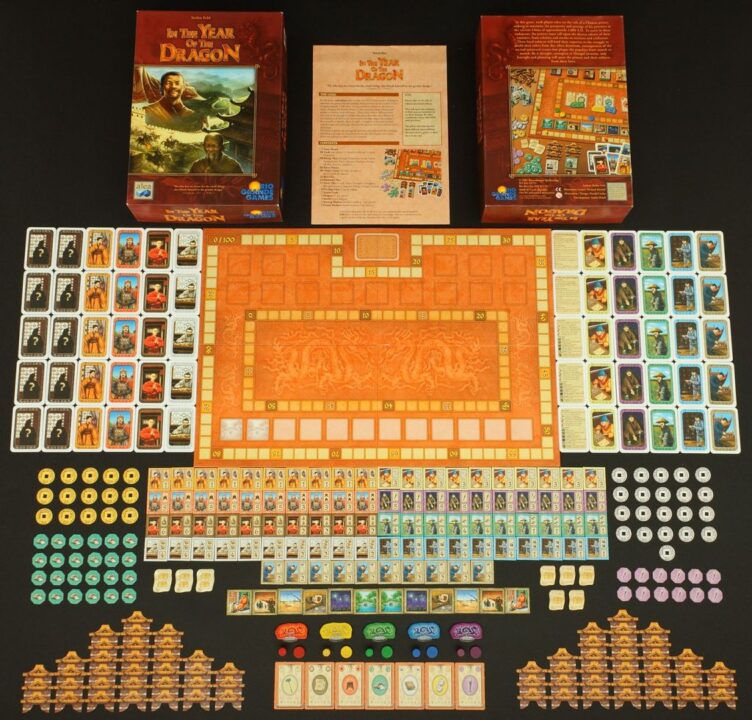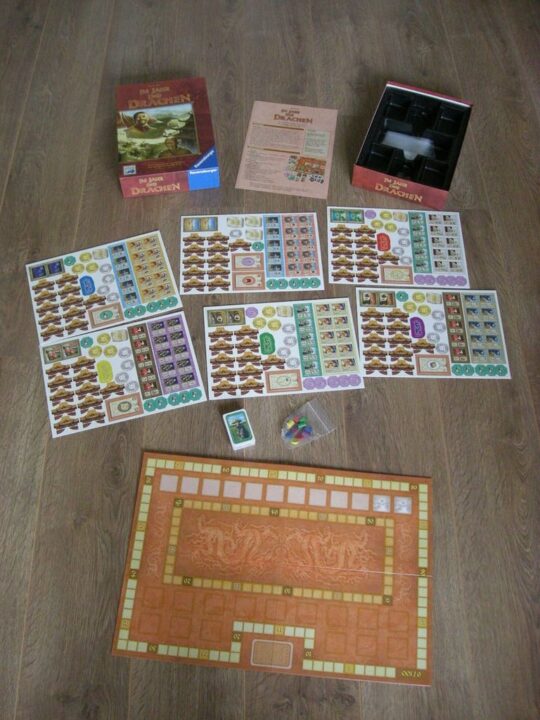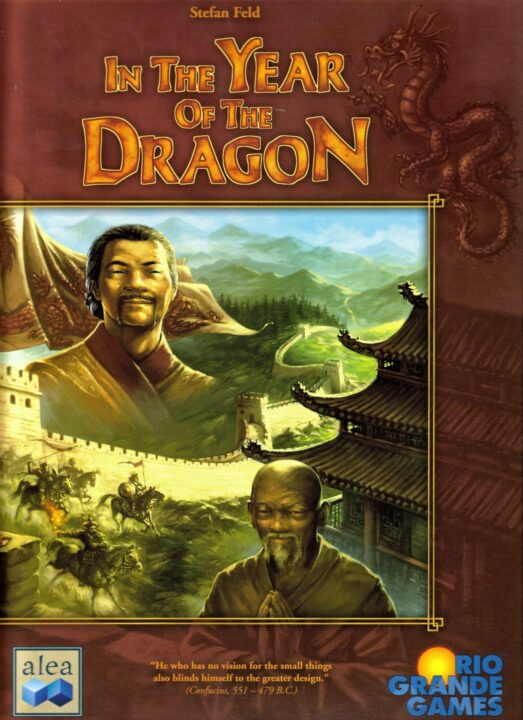Overview
Welcome to my board game corner where today’s spotlight shines on In the Year of the Dragon. In this review, we will delve deep into the strategic intricacies and social dynamics that make this game a standout in every gaming library. Famed designer Stefan Feld’s creation will sit under our microscope as we assess the resource management rigors, the player turn order chess match, and the deft dance of crisis mitigation and recovery. So, fasten your seatbelts — we’re about to take a ride through imperial China to discover what makes this game tick.
How It Plays
Setting Up
‘In the Year of the Dragon’ begins by players choosing their starting person tiles and placing their markers on the scoring track. The palace floors are filled according to the number of players, event tiles are shuffled and laid out for the year, and each player receives resources according to their chosen starting tile.
Gameplay
Each turn starts with players selecting person tiles that provide resources, or slots in the palace. Careful selection is vital in preparing for events such as disease, famine, or invasion. Planning starts off strategic and heightens as events unfold, ensuring no two games play alike.
Winning the Game
The game ends after the final event, firework display, is completed. Players score for their remaining person tiles, their level in each of the three Dragon award categories based on their palace inhabitants, and leftover resources. The highest score proves the winning dynasty, having successfully navigated a challenging year with grace and guile.
Want to know more? Read our extensive strategy guide for In the Year of the Dragon.
A Glimpse into Methodical Mastery
Strategic Foundations Every board gamer has that ‘aha’ moment, where the scales of luck and strategy tilt definitively towards the latter. For me, it crystallized during a nail-biting session of In the Year of the Dragon. There’s a taut thread of anticipation woven through the game – you’re carefully hoarding resources to mitigate the onslaught of events. Like a chess player, I found myself thinking multiple turns ahead, every action interlocked with potential outcomes.
Anecdotal Alignments Curiously, the moment of glory often springs from earlier decisions. I vividly recall how a seemingly minor action, banking on a serendipitous blend of courtier talents, later burgeoned into a triumph. Resource Management and Planning is the bedrock upon which victories in this game are edified. Subsequently, orchestrating my court to capitalize on my strategy often meant heart-racing calculations and precarious gambles on every turn.
Strategically seguing, one cannot underestimate the pivotal role that Player Turn Order Strategy plays following such meticulous planning.
![In the Year of the Dragon - [Edit to add caption] Game in play - Credit: garyjames](https://toppingthetable.com/wp-content/uploads/2023/12/pic263008.jpg)
Making Every Turn Count
In the realm of board games, the significance of player turn order can’t be overstressed. I recall one intense session of ‘In the Year of the Dragon’ where turn order played a crucial role in our overall strategies.
Jumping Ahead
Initially, the leapfrogging mechanic felt counter-intuitive. However, strategically it’s pure gold—timing your jumps to claim pivotal actions reshaped our gameplay and outcomes dramatically.
Wait for it…
Adversely, patiently waiting and accruing resources before a big move proved just as valuable. A particularly memorable turn witnessed a friend skillfully jumping in at just the right moment to manipulate events in her favor.
The art of perfectly timed positioning will soon give way to mastering the nuances of Crisis Mitigation and Recovery.

Weathering the Storm in ‘In the Year of the Dragon’
Each time I’ve played In the Year of the Dragon, the reality of crisis management becomes a central, gripping challenge. After all, strategy is meaningless unless it factors in the unexpected. Moreover, this game excels in teaching that vital lesson.
Anticipating Crises
I remember one session where, despite careful planning, a double-whammy of events hit us back-to-back. The group’s lively debates on how to prepare for forthcoming crises became just as strategic as any resource management.
The Recovery Phase
The true test of a player’s forward-thinking abilities is recovery. Can you bounce back and rebuild your resources? Easier said than done, but the satisfaction of successfully navigating disasters is unforgettable.
In conclusion, the intricate dance of crisis mitigation and recovery is a core aspect of In the Year of the Dragon that I thoroughly recommend for those who relish mastering complexity under pressure.

Conclusion
As we wrap up this review, it’s clear that ‘In the Year of the Dragon’ demands strategic finesse and the ability to adapt to ever-changing conditions. The central resource management mechanic calls for clever planning, and jockeying for position during player turns requires acute tactical awareness. Navigating the game’s periodic crises pushes players’ risk management skills to the limit. Whether it’s because you enjoy the tension of looming threats, the lively player interaction, or you’re just a fan of Stefan Feld’s intricate designs, this game has something to everyone who relishes thoughtful and engaging gameplay. Signing off, I wholeheartedly recommend ‘In the Year of the Dragon’ to gamers who revel in a challenge.


